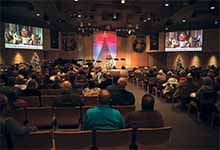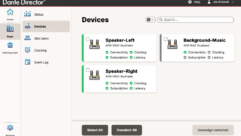

DSP and Dante
Networking for Worship Supports Practical and Spiritual Goals
It’s easy to think that audio and video networks are about signal—moving, processing, controlling, and programming signal. But a good network is about much more than that. In the case of Cornerstone Church in Long Beach, CA, the network allowed the church to avoid a costly physical expansion by maximizing their existing space; the resulting system also better served Cornerstone’s core mission.
It took some convincing, says Chuck Mitchell owner of system designer/ integrator TechArts. But when the pastor articulated that Cornerstone was a “communication-based organization,” Mitchell knew how to frame the network to match that vision. As a practical matter, Cornerstone needed more space to accommodate a growing congregation. They had committed to expanding the main sanctuary within the building footprint, but they really needed to expand the flexibility of the rest of the building too, including the lobby, hallways and multi-purpose rooms. If that could work, it would be preferable to investing in more facilities and more property.

TechArts chose a DiGiCo console for the main sanctuary “because it sounds so sweet,” Mitchell says. (He’s also a composer,mixer, and sound engineer). However since DiGiCo has not made Dante compatibility a focus, an intermediary was necessaryto take the full complement of console channels to the network. In this case the bridge was a Focusrite Rednet 6 to convert 64channels of MADI to Dante and back.
If audio and HD video sources could go anywhere, anytime, the existing rooms and corridors could be reconfigured on the fly. This wouldn’t just give the congregation more space, it would give them many more options for communication and for bringing people together in different ways. The building could be broken into zones, unified into one space, and everything in between, depending on what the congregation needed on any given day.
“They got a full return on a much smaller investment through the network-based design, which completely maximizes the many uses of each room as overflows or individual teaching spaces, all with the touch of a button,” Mitchell explains. Further, by using a distributed network, they could avoid the space demands and configuration restrictions of a matrix switcher and a dedicated rack room.

The Dante VLAN add SVSi-based video VLAN share the same routers.
The building incorporates six zones, the sanctuary, a lobby, a youth room, two multipurpose rooms, and an inviting community meeting/overflow space.
TechArts had designed and integrated Cornerstone’s previous AV design without a network. Much of the existing gear was good quality with life left in it, so the network had to incorporate both new and legacy gear, with varying levels of network-readiness.

As an alternative to a capital building expansion, Cornerstone Church was able to expand capacity through the use of a Dante/Symetrix audio network combined with an SVSi-based videonetwork. This network allows any source to go anywhere, allowing the rooms to be used independently or combined into various configurations for room combining and/or overflow. Click here to see a larger image.
Mitchell and his programmer Jason Vandergrift had experience with Dante networks (as well as with CobraNet, Opticore, and Aviom). “I had no hesitation to move to Dante; I knew that it was being implemented in a lot of the equipment I wanted to use. I’ve had great experiences with it and knew it was reliable.”
The Dante network is tied together through three Symetrix Radius 12×8 processors spread throughout the building; Mitchell and programmer Vandergrift used the Symetrix SymNet Composer to configure the network devices and DSPs.
TechArts also supplied analog connectivity as needed. which was initially reassuring to church leaders. Since then, Mitchell says, they clearly prefer the digital sound and the analog connectivity remains largely unused.
Much of the existing audio equipment in the main sanctuary was repurposed into the youth worship center making room for updates in the sanctuary. The audio playback is Danley speakers and QSC amps. The mixer is a Digico.
Another of the spaces, which church leaders call the courtyard, is a core gathering place for meetings, presentations or coffee shop-style worship. Or, with the push of a single button, it can assume an overflow role for any other room in the building. An Apple TV drives an 80” flatscreen that can carry HD sources from anywhere in the facility; the Tannoy ceiling speakers and subs can do the same with any audio source.
DSP and Dante
Dec 26, 2014 5:26 PM, By Cynthia Wisehart
Networking for Worship Supports Practical and Spiritual Goals

Click here to see a larger image.
Key to this area was a minimal impression of technology, free of racks or visible equipment other than the hero flatscreen and the flush mount speakers. The solution was integrated iPad control, and a custom architectural connection panel with all amplifier and processing equipment located remotely. A simple, wall-mounted Extron touchpanel was programmed to offer simple master controls.
The new youth room is anchored by a Yamaha console that moved from the sanctuary to support the youth stage. A 16-channel Dante network card got it onto the network. Like the courtyard, this room has Tannoy ceiling speakers and QSC amps. Modern projection and lighting set the tone, and simple Extron touchscreens with Pro or Novice mode (or iPad controls) make the room easy to use. TechArts programmed simple Extron touchpanels to offer “Professional” or “Novice” mode, so the sanctuary can be run without an audio engineer if necessary. “That’s something we do a lot,” Mitchell says, “so we have a lot of experience getting people the user interface they want, whether they are accommodating professionals or volunteers—and usually both.” Like all the other spaces the Dante/SVSi-based network provides for room-combine and overflow.

Click here to see a larger image.
Two adjoining multi-purpose classrooms, were also designed with an integrated audio/video network so that they can serve as an overflow for any of the other venues. Like the courtyard space, they have Apple TVs and local connectivity so they can be used independently or in tandem, depending on how the sound-wall dividers are deployed. Each room has room-combine options (again from a simple Extron touchscreen) to allow either of the classrooms to combine with each other and/or the larger youth room.
“The key to this project was the pastor’s statement about being a communication-based organization. We took the tools and thought about what could be, not what had always been done. That’s easier to do when you have a very clear picture of the client’s application and mission. Like they say, let concept be king. When you know that concept, it drives everything. They wanted to be a communications organization and reach as many people within their existing space as they could. Networks gave us a bigger palette to do that.”
PRODUCT AT WORK: SYMETRIX SYMNET COMPOSER
This open architecture design software for SymNet DSPs and a growing number of third-party devices is now in version 3.0. Integrators can streamline their set-up procedures and execute network discovery, Dante signal routing, and audio set-up of supported devices. Composer is the only programming environment needed to build a Dante networked system from start to finish; it simplifies and speeds initial design, revisions, and troubleshooting.

AUDIO + VIDEO
Like the audio network, the video network is a distributed network utilizing the SVSi JPEG2000 encoders and decoders. “We’re fans,” Mitchell says. Without the restrictions of a centralized star network he can simply and inexpensively add end points to the network at any time. “The product has been solid for us.”
There is quite a bit of video display in the building—including two 7500 lumen Mitsubishi DLP WUXGA projectors in the sanctuary, as well as a suite of Blackmagic distribution and production gear. An array of flatscreens are deployed throughout the remaining rooms.
Mitchell says the biggest challenge that he and his indispensible programmer Jason Vandergrift faced was integrating the Dante and SVSi networks to share the same routers. “Dante and SVSi were very similar in their router requirements, but they had different set ups. Our goal was to set up VLANs for each within the same router.” The challenge was to find the router configuration that would be useful for both.” Obviously that’s not something you can put on the manufacturers because they can’t troubleshoot each other’s gear, so Mitchell and Vandergrift tackled it themselves “It was a lot of trial and error and we came up with a proprietary solution that may pay us back some day.”










